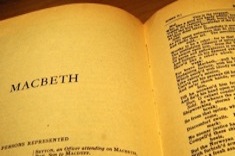I love to start out the study of Hamlet with these instructions for my students: “Number your paper from 1-4. In this order, write down your name, your mother’s name, your father’s name, and the name of a paternal uncle. Now, cross out your father’s name — he has just passed away. Draw a line to connect your mother’s name to your uncle’s. A month has just passed and these two are now married. How does that make you feel?”
I am immediately met with outbursts of disgust and disbelief.
“Ewww! Gross!”
“That’s just wrong!”
Then I proceed to tell them that this is what Hamlet is dealing with at the beginning of the play, and he is reacting in much the same way that they are. The students now have an immediate connection to Hamlet and his emotions. Since the entire play revolves around Hamlet thinking through his emotions, this activity provides a critical first step to understanding this complex character and his motivations.
In addition, the fact that Hamlet spends more time thinking about what he should do (he has seven soliloquies in the play!) rather than acting on it, the play lends itself very well to the close reading which is emphasized so heavily in the Common Core State Standards. Close reading requires students to read and reread a text deliberately, and anyone who has ever read Shakespeare before knows that this process comes with the territory. Who among us has been able to read a Shakespearean play from cover to cover with an absolute understanding of the characters and plot? The nature of Shakespeare’s dense and many times archaic language makes his plays an obvious choice for practicing slow and deliberate reading. Hamlet is overflowing with interesting turns of phrase, tricks of language, and vivid imagery for students to unpack, and they can have fun doing so in the process.
On a typical day, students come to class having read and responded to assigned scenes. This gives students a basic knowledge of what is happening in the scene, and we can then work on a closer reading in class to tease out the more subtle details. Through this process, the students’ first (and probably second) reading of a scene is to gather an understanding of the plot, while their subsequent readings allow them to look at the language to infer the deeper meaning of the text.
A good starting place is the speech that Claudius (Hamlet’s uncle/new step-father and king) gives to the people of Denmark. On the surface, it appears to be your typical state of the union address, but a closer look reveals how Claudius really feels about Hamlet. With a little help, students can notice that Claudius continues to use the formal royal “we” even when addressing Hamlet, his relative. They can also pick out many uses of antithesis, juxtapositions, and oxymorons in the speech, all of which lead them to the conclusion that Claudius seems a bit dubious in regards to his care for Hamlet and his sorrow over the death of his brother.
Through close reading, students also enjoy discovering how Hamlet uses puns to articulate his true feelings, while appearing to be the obedient prince on the surface. For example, when Claudius asks him in regard to mourning his father, “How it is that the clouds still hang on you, Hamlet replies, “Not so, my lord. I am too much in the sun.” Almost every student can see the play on the word “sun,” where Hamlet appears to be telling Claudius that he is fine, yet at the same time admitting that he isn’t because he is too much his father’s “son.” My students love uncovering these double meanings throughout the play, and, because they are your typical adolescents, the fact that some of Hamlet’s puns are rather bawdy doesn’t hurt either. It is only through the act of repeated and close reading that students are able to unearth these interesting uses of language and get to the core of Hamlet’s feelings and emotions.
Another activity that I use to get students reading closer and deeper is “physicalizing” a soliloquy. This activity requires students to think not only about what Hamlet is saying, but about how he gets that meaning across. We start with the first soliloquy that begins “O, that this too, too sullied flesh would melt.” In groups of three or four, students comb through the speech looking for the imagery and language patterns that stand out and help to convey the message that Hamlet is heartbroken over his current family situation. Their task is to highlight the imagery and bring this soliloquy to life. The groups can do this through the use of props, drawings, or students posing as statues. For example, while one student, acting as the narrator, reads the word “sullied,” another group member can hold up a drawing of a dirty old sock. And when the narrator gets to the word “melt,” other students in the group can pantomime a melting ice cube. This activity not only helps students “see” what Hamlet is saying, but it prompts wonderful discussion about how imagery can convey different shades of meaning.
As the story of Hamlet unfolds, some students find Hamlet to be cautious and smart in his quest to avenge his father’s death, while others start to view him as an overdramatic whiner. Whatever their opinion of the title character is, by the end of the play my students have plenty of evidence to support their view as a result of the close reading we have done. We have weighed and reflected upon Shakespeare’s words and sentences, and they have helped us get better acquainted with one of his most famous characters.






